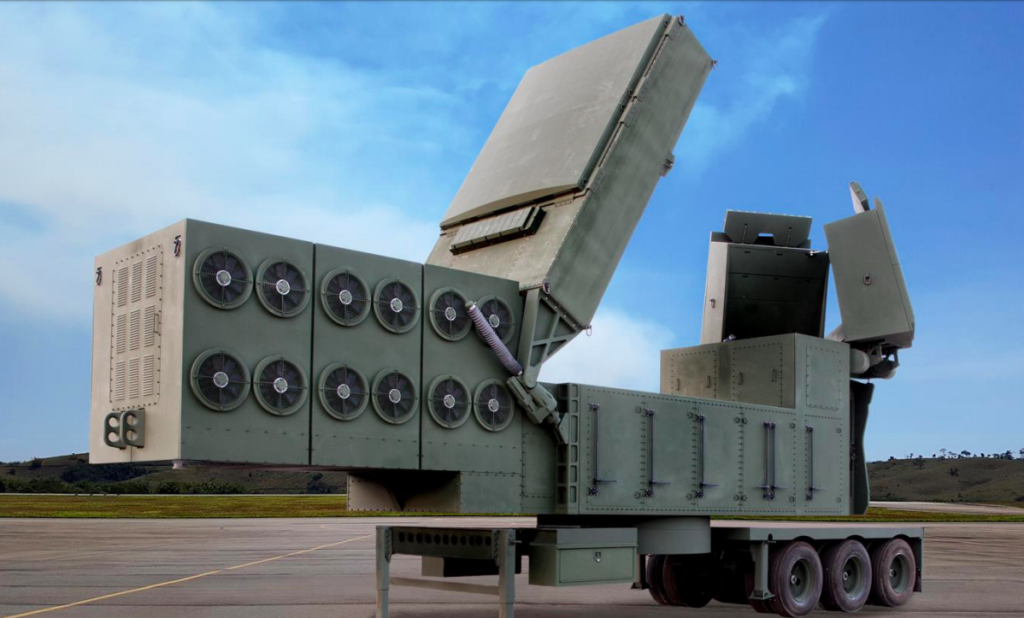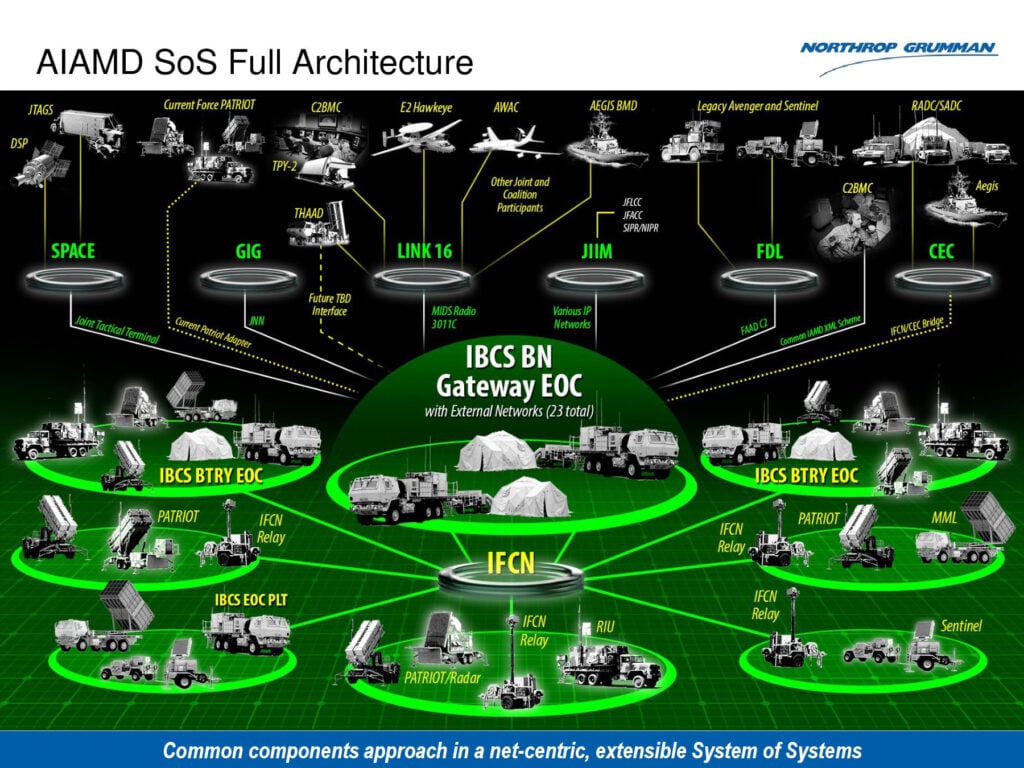
Raytheon design for the Lower-Tier Air & Missile Defense Sensor (LTAMDS)
WASHINGTON: Raytheon has won a $383 million contract to build the first six radars for the Lower-Tier Air & Missile Defense System. LTAMDS will be the fundamental building block of the Army’s future defenses against everything from terrorist drones to supersonic cruise missiles.
A full-size mock-up of the Raytheon radar was prominently on display at this week’s Association of the US Army conference. The company even handed out red lanyards emblazoned with “no time for a blind spot” to advertise the radar’s 360-degree coverage.
Moving under an accelerated Other Transaction Authority procurement and scheduled to enter service in 2022 – during Phase I of the Army’s newly released 16-year modernization plan – LTAMDS is one of the Army’s 31 officially designated top-priority programs. While other systems like hypersonic missiles, robotic tanks, and high-speed aircraft are ahead of air and missile defenses on the Army’s list, stopping Russian or Chinese missile salvos is essential to survival in a future great-power war. As then-Army Chief of Staff Gen. Mark Milley put it: “None of that’s going to matter if you’re dead.”
LTAMDS was originally conceived of as a replacement for the aging radar in Patriot missile defense units. But it has evolved into the multi-purpose linchpin of the Army’s planned Integrated Air & Missile Defense, able to detect enemy drones, helicopters, jets, and missiles both cruises and ballistic. Instead of connecting only to Patriots, LTAMDS will feed target data over the new IBCS network to any Army interceptor. (In fact, it’s the first Army system to be designed to work with IBCS, instead of having to be modified).
When the LTAMDS program began, Raytheon exec Bob Kelley told reporters this morning, “our first thought was, ‘let’s do a Patriot upgrade.’” But the more the company looked at the Army’s requirements, the more they realized it would take an all-new design to meet them.

A simplified (yes, really) overview of the Army’s IBCS command-and-control network for air and missile defense.
The 360-Degree Solution
By picking Raytheon’s radar, which provides 360 degree coverage, the Army settled the big uncertainty over LTAMDS: whether the radar would be able to watch for threats from all directions at once.
The current Patriot can only watch one slice of the sky at a time. That wasn’t originally a problem, because Patriot was mainly used against ballistic missiles like the Iraqi Scud, which fly very high and fast but in a highly predictable (ballistic) trajectory. However, more and more adversaries — from Houthi insurgents to the Chinese — employ cruise missiles and drones, which, while lower and slower, are more maneuverable and can come from all directions, as was brutally demonstrated by the recent Iranian surprise attack on Saudi oilfields.
The Army decided not to include 360-degree coverage in its official minimum requirements for LTAMDS. The service said it could get adequate coverage by using multiple narrow-field-of-view radars, each aimed in a different direction, but sharing data over the network, and then using software to stitch together a complete picture at the command post.

Tom Karako
That was a decision vehemently criticized by one of Washington’s leading missile defense experts, Tom Karako of CSIS. The normally reserved Karako even published a 1,200-word op-ed in Defense News calling out the Army.
Today, Karako’s relieved. “Over the past few years, I’ve been a broken record on the need for omnidirectional air defense, rather than sectored coverage,” he told me in an email. “LTAMDS is one of several ways in which the Army and the Joint Force more broadly have come to recognize the complex nature of today’s aerial threats and begun to adapt accordingly.”
An important caveat: while the Raytheon radar can see in all directions, it can’t see equally well in all directions. That’s obvious from its design, with one large main array flanked by two smaller arrays, each of them fixed in place on a shared platform.
Raytheon’s Kelley confirmed it this morning in a call with reporters. “Against certain types of threats,” he said, the radar is equally capable in all directions, providing essentially a perfect circle of coverage. But the main frontal array is capable of detecting threats at higher altitudes than the side panels, he said.
Now, this is probably a smaller problem than it sounds. Why? Remember what we said about the difference between ballistic missiles, on the one hand, and “air-breathing” threats like cruise missiles and drones on the other. Ballistic missiles come in at staggering speeds – easily five times the speed of sound – from very high altitudes, because the ballistic courses which give them their name arc into the upper atmosphere and even through outer space. But the price of such speed is that ballistic missiles can’t turn: Except for very advanced models in their final stages of flight, they follow a course as predictable as a cannonball. So if you know roughly where your enemy’s launchers are, you can confidently point your radar in that direction.
By contrast, cruise missiles, drones, and manned aircraft can maneuver throughout their flight path, and they can come in low, but they can’t achieve the same extreme speed and altitude as ballistic missiles. That means the Raytheon LTAMDS’s side panels, with their limited high-altitude coverage, are probably still adequate to detect them far enough away for defenders to react.
Those side panels aren’t puny, either: Each one, though half the size of the current Patriot radar, is twice as powerful, Kelley said this morning. In other words, LTAMDS’ ability to detect sneak attacks from behind is twice as good as Patriot’s ability to detect a frontal attack.
How is this possible? Raytheon has spent decades investing in a next-generation material for radars, Gallium Nitride (GaN), that conducts electricity more efficiently than traditional Gallium Arsenide (GaAs). That means the same input in terms of electrical power produces a greater output in terms of radar range, precision, and search volume. Other companies have moved into GaN as well, but Raytheon actually has its own in-house foundry to build Gallium Nitride electronics on US soil, in Andover, Mass.
The company also opened a new factory for its radars just last year that uses advanced manufacturing techniques, something Army Secretary Ryan McCarthy is eager to encourage. At one point on the line, there’s a robotic self-driving cart that brings supplies to another robot which works with yet a third robot to put together radar components. That allows much faster production, Kelley said — with his eye clearly on future US and export sales.
Connecticut lawmakers to grill Army, Lockheed about job cuts at Sikorsky helicopter unit
“The Connecticut delegation has questions about why, with that [FY24] appropriation in hand, this happened,” said Rep. Joe Courtney, D-Conn.



























